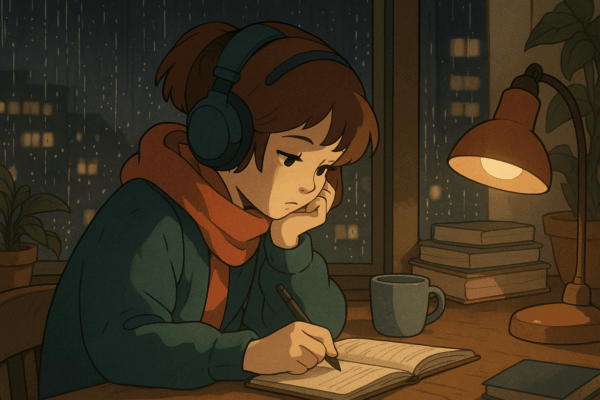In recent years, lo-fi music has emerged as a beloved genre for students, creatives, and chill-seekers around the world. Characterized by its warm, nostalgic tones and laid-back rhythms, lo-fi music has become the go-to background soundtrack for studying, relaxing, and introspection.
But what exactly is lo-fi? Why has it exploded in popularity, and what makes it so appealing?
Let’s dive into the world of lo-fi music and discover the elements behind its success.
The Meaning of “Lo-Fi”
“Lo-fi” stands for low fidelity, which originally referred to music with imperfections in sound quality — such as background noise, static, or unrefined mixing. These elements were once considered flaws, but in lo-fi, they’ve become defining features.
Rather than chasing studio perfection, lo-fi embraces the raw, imperfect beauty of analog-style production. The result? Music that feels human, cozy, and authentic.
Origins of Lo-Fi Music
Lo-fi music has roots in various genres and decades:
- 1960s–80s: Artists like The Beach Boys and Daniel Johnston recorded with cheap equipment, unintentionally creating lo-fi aesthetics.
- 1990s: The underground hip-hop scene embraced lo-fi sounds, with producers using vinyl samples, jazz chords, and boom-bap beats.
- 2000s–2010s: Producers like J Dilla and Nujabes helped shape what we now recognize as lo-fi hip-hop.
The modern lo-fi genre as we know it today took shape on platforms like YouTube and SoundCloud, where creators uploaded beat tapes that fused mellow hip-hop rhythms with ambient and jazzy textures.
Lo-Fi Hip-Hop: The Subgenre That Took Over
The most popular form of lo-fi is lo-fi hip-hop, a chilled-out subgenre that often features:
- Laid-back, looped beats
- Jazz and soul samples
- Vinyl crackles and ambient background noises
- Slow BPM (beats per minute)
- A relaxing, daydreamy atmosphere
This genre exploded with YouTube streams like lofi hip hop radio – beats to relax/study to, which became cultural phenomena.
Why People Love Lo-Fi
1. It’s Perfect Background Music
Lo-fi is often instrumental, which makes it great for studying, working, or sleeping. Without lyrics to distract, the music fades into the background while still setting a chill mood.
2. It Feels Nostalgic
The analog textures and vintage samples evoke a feeling of the past — like flipping through an old photo album. Lo-fi creates an emotional connection, even without words.
3. It’s Accessible and Relatable
Many lo-fi tracks are produced by independent artists in home studios. There’s no barrier of celebrity or corporate polish, which makes the music feel personal and grounded.
4. It Encourages Mindfulness
With its slow tempo and minimalist structure, lo-fi helps listeners stay calm and present. It’s often used for meditation, journaling, or mental clarity.
The Role of Visual Aesthetics
Lo-fi isn’t just about sound — it’s also a visual culture. The genre is often associated with looping animations, anime art styles, rainy windows, cozy bedrooms, and vintage vibes.
This aesthetic became synonymous with the genre and helped build a strong online identity for lo-fi music.
Lo-Fi in the Streaming Era
Streaming services like Spotify, Apple Music, and YouTube have embraced lo-fi. Curated playlists such as:
- “Lo-Fi Beats”
- “Chillhop Essentials”
- “Beats to Sleep To”
…receive millions of plays daily.
Lo-fi’s non-intrusive nature makes it perfect for algorithmic playlists, helping it reach wide and diverse audiences.
The DIY Spirit of Lo-Fi Producers
One of the most empowering aspects of lo-fi is its DIY ethos. Many producers start with just:
- A laptop
- Basic digital audio workstation (DAW)
- Sample packs or vinyl records
- A MIDI keyboard or drum pad
The genre encourages experimentation, with thousands of creators uploading their tracks to Bandcamp, SoundCloud, and YouTube, often gaining large followings without industry backing.
Criticism and Oversaturation
Despite its popularity, some critics argue that lo-fi has become too formulaic — with endless playlists sounding almost identical.
But others see this uniformity as a strength: it creates a safe, consistent sound environment that people rely on to stay focused or calm.
Final Thoughts: More Than Just “Study Music”
Lo-fi music is more than a background soundtrack — it’s a cultural movement. It represents a rebellion against overproduced commercial sounds and a return to simplicity, intimacy, and mood.
Whether you’re winding down after a long day or deep in a late-night study session, lo-fi offers a comforting, lo-tech escape in a high-speed digital world.

